|
Teguar TD-45-22 Industrial Monitor
A series of industrial touch screen monitors for the most demanding applications
(by Conrad H. Blickenstorfer)
Share on:



In this article we're discussing one of Teguar's many industrial monitors, the 21.5-inch TD-45-22. Monitors, of course, are separate, freestanding displays that hook up to a computer. When PCs first became available a few decades ago, almost every computer had a freestanding monitor to go with it. Today, due to the proliferation of laptops, tablets and smartphones, there are far fewer freestanding monitors. Even desktop computers are often all-in-ones now — the computer built right into the monitor. Yet, in the industrial sector (and many other sectors), separate monitors remain popular. Why is that?
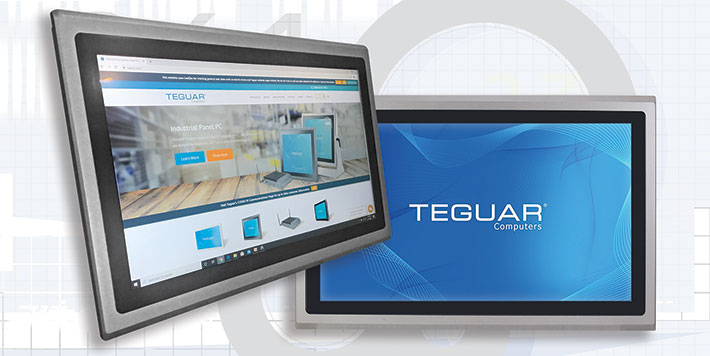
Mostly because in industrial settings, PCs are rarely used on desks or other traditional office type of locations. They may be on shop floors, in vehicles, along assembly lines, or placed in protected spaces out of harm's way. Or the monitors may be built into panels, installed on articulating arms, mounted on poles, walls, or wherever else they are needed.
There are also other reasons for the presence of industrial monitors. Displays used in industrial applications must be tough and rugged, something which consumer monitors, or any consumer technology displays, definitely are not. Smartphones and consumer tablets are now so slender that a protective case is mandatory. Desktop monitors are getting ever larger, thinner, and, as a result, flimsier. There are now 65-inch OLED TVs that are less than an eighth of an inch thick. All those consumer technology displays are gorgeous, but there is not a chance that they can be used in industrial environments.
Teguar's industrial touch screen monitors: concept and models
Industrial monitors are different. They are built from the ground up to withstand the perils of industrial environments. And since industrial monitors are, for the most part, stationary or fixed-mount devices, weight is much less of an issue than it is with mobile computers. As a result, while there is a substantial difference between a rugged and a non-rugged laptop or tablet, the difference between a run-of-the-mill office monitor and an industrial monitor is far greater. Industrial monitors are truly built like tanks. Here are the primary features of Teguar's industrial monitors:
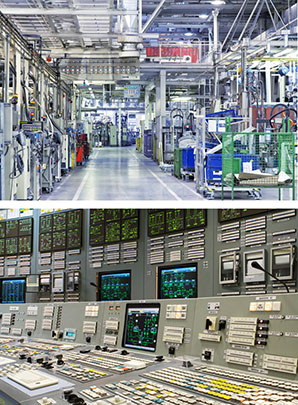
- All use rugged, heavy-duty steel and die-cast aluminum enclosures that are nearly indestructible.
- They come with displays as small as 7-inches diagonal and as large as 22-inches diagonal.
- All have an IP66-protected flat front panel that are fully protected from dust and can handle strong jets of water.
- All models are available with resistive or optional projected capacitive touch screens (the latter in IP69K-rated versions).
- All have a wide 9~36 Volt DC power input range.
- All models offer optional high-bright sunlight-readable 1000 Nits LCDs.
- Most models have four different video ports (VGA, DVI-D, HDMI, DP) to accommodate connection to various host computers.
- Display resolutions and pixel density vary between models, and different luminance options are available for all models.
At this point you may wonder why, given the common availability of Panel PCs that combine computer and display, there's even a need for separate industrial monitors. Teguar points out that separating the computer from the display is often necessary or desirable in industrial settings for a variety of reasons.
For example, while industrial computers are by definition reliable, failures can still happen. In that case, it's often easier and less costly to repair or replace just what broke down instead of the entire system. There are also applications where displays are exposed to potential abuse (environment, vandalism, etc.). Again, replacing just the monitor instead of a whole Panel PC is less costly and disruptive. Finally, separation of PC and display allows for a much wider range of matching computing power and screen size to an application.
The table below shows Teguar's entire range of TD-45 Series industrial monitors:
|
Teguar TD-45 Series Industrial Monitor lineup
|
|
Company
|
Teguar
|
Teguar
|
Teguar
|
Teguar
|
Teguar
|
Teguar
|
Teguar
|
Teguar
|
Teguar
|
Teguar
|
|
Model
|
TD-45-07
|
TD-45-08
|
TD-45-10
|
TD-45-12
|
TD-45-15
|
TD-45-16
|
TD-45-17
|
TD-45-18
|
TD-45-19
|
TD-45-22
|
|
Actual size
|
7.0-inch
|
8.0-inch
|
10.1-inch
|
12.1-inch
|
15.0-inch
|
15.6-inch
|
17.0-inch
|
18.5-inch
|
19.0-inch
|
21.5-inch
|
|
Resolution
|
800x480
|
800x600
|
1280x800
|
1024x768
|
1024x768
|
1366x768
|
1280x1024
|
1366x768
|
1280x1024
|
1920x1080
|
|
Opt. res.
|
NA
|
NA
|
NA
|
NA
|
NA
|
1920x1080
|
NA
|
NA
|
NA
|
NA
|
|
PPI
|
133
|
125
|
149
|
106
|
85
|
100
|
96
|
85
|
76
|
102
|
|
Aspect ratio
|
15:9
|
12:9
|
16:10
|
12:9
|
12:9
|
16:9
|
15:12
|
16:9
|
15:12
|
16:9
|
|
Colors
|
262k
|
16.2m
|
16.7m
|
16.2m
|
262k/16.2m
|
16.7m
|
16.2m/16.7m
|
16.7m
|
16.7m
|
16.7m
|
|
Luminance
|
350/1000
|
350/1000
|
350/1000
|
450/1000
|
420/1000
|
300/1000
|
350/1000
|
300/1000
|
350/1000
|
250/1000
|
|
Resistive
|
Standard
|
Standard
|
Standard
|
Standard
|
Standard
|
Standard
|
Standard
|
Standard
|
Standard
|
Standard
|
|
P-Cap
|
Optional
|
Optional
|
Optional
|
Optional
|
Optional
|
Optional
|
Optional
|
Optional
|
Optional
|
Optional
|
|
Power
|
DC 9~36
|
DC 9~36
|
DC 9~36
|
DC 9~36
|
DC 9~36
|
DC 9~36
|
DC 9~36
|
DC 9~36
|
DC 9~36
|
DC 9~36
|
|
Weight (lb)
|
2.2
|
4.0
|
4.6
|
6.0
|
9.5
|
9.7
|
13.0
|
14.1
|
13.7
|
16.8
|
|
Size (mm)
|
202x149x40
|
231x176x50
|
285x189x49
|
319x245x52
|
410x310x55
|
412x278x59
|
439x348x65
|
500x315x60
|
468x380x65
|
468x380x65
|
|
VGA
|
yes (1)
|
yes (1)
|
yes (1)
|
yes (1)
|
yes (1)
|
yes (1)
|
yes (1)
|
yes (1)
|
yes (1)
|
yes (1)
|
|
DVI-D
|
yes (1)
|
yes (1)
|
yes (1)
|
yes (1)
|
yes (1)
|
yes (1)
|
yes (1)
|
yes (1)
|
yes (1)
|
yes (1)
|
|
HDMI
|
no
|
no
|
no
|
yes (1)
|
yes (1)
|
yes (1)
|
yes (1)
|
yes (1)
|
yes (1)
|
yes (1)
|
|
DP
|
no
|
no
|
no
|
yes (1)
|
yes (1)
|
yes (1)
|
yes (1)
|
yes (1)
|
yes (1)
|
yes (1)
|
|
USB
|
1 Type A
|
1 Type A
|
1 Type A
|
1 Type B
|
1 Type B
|
1 Type B
|
1 Type B
|
1 Type B
|
1 Type B
|
1 Type B
|
|
RS232
|
Optional
|
Optional
|
Optional
|
Optional
|
Optional
|
Optional
|
Optional
|
OptionalB
|
Optional
|
Optional
|
|
Max draw resistive
|
4.2 watts
|
4.7 watts
|
6.2 watts
|
7.9 watts
|
12.5 watts
|
12.2 watts
|
11.6 watts
|
19.7 watts
|
16.8 watts
|
18.3 watts
|
|
Max draw P-Cap
|
4.2 watts
|
3.6 watts
|
6.2 watts
|
14.8 watts
|
17.6 watts
|
12.3 watts
|
27.3 watts
|
30.2 watts
|
18.3 watts
|
24.9 watts
|
The table highlights the similarity and cohesiveness between the ten models of the Teguar TD-45 industrial monitor series listed as of April 2020. They all share the same basic design, but vary in display size from 7 inches diagonal all the way to 21.5 inches diagonal.
Note the variety in display aspect ratios between the various models, ranging from a squarish 15:12 in the 17-inch model to the wide-format 16:9 in the 18-inch model and the 22-inch version we tested. The 8-inch, 12-inch, and 15-inch models have displays with the older 4:3 aspect ratio. Each aspect ratio has its uses, software coded for it, or applications that work best with it.
As is to be expected from the large range of screen sizes, display resolution varies — from 800 x 480 pixel in the smallest unit, up to 1920 x 1080 pixel in the largest. Pixel density varies widely also, from 149 ppi (pixels per inch) on the 10-inch monitor, down to just 76 ppi in the 19-inch version. Note that pixel density is not an absolute where higher density is always better. Pixel density must be matched to display size and application. There are smartphones with insanely high pixel densities in the 850ppi range, but an "ultra-high definition" 70-inch 4k TV only has 63 pixels per inch. It all depends on the application and the viewing distance.
Note that the 4:3 aspect ratio/1024 x 768 pixel format has long been a standard for many industry-specific software applications and solutions, whereas 16:9/1920 x 1080 pixel is generally favored for multi-media and video applications. Another difference between the displays is their default luminance, which ranges from 250 (22 inch) to 450 (12 inch) nits in this lineup. All ten screen sizes, however, are also available with a super-bright 1,000 nits option for outdoor applications.
Now let's take a closer look at the TD-45-22 sample unit Teguar sent RuggedPCReview.com for evaluation and testing.
Teguar TD-45-22 21.5-inch monitor
The TD-45-22 is the largest model of Teguar's industrial monitor series. Its display measures 21.5 inches diagonally in the wide-format 16:9 aspect ratio, just like the home and office-oriented Apple iMac 21. The Teguar industrial-grade monitor, however, weighs almost 17 pounds, whereas the slender iMac21 weighs just 12.5 pounds, even though it is an all-in-one and not just a monitor. And that, in a nutshell, is the fundamental difference between a consumer market design (as light and thin and comprehensive as possible) and an industrial-grade one (as tough and durable as the job requires).
The first impression anyone will have of the Teguar TD-45-22 is how heavy and incredibly solid it feels. The monitor looks like it's milled out of a solid block of steel. That would neither be necessary nor feasible, but this Teguar monitor (and in fact the entire line) is the next best thing: die-cast aluminum front and back, and a steel box between.
The steel parts of the housings are made from what looks to be 16-gauge steel (roughly 1.5mm), which is considerably thicker than auto body sheet metal. The sides of the steel box have cutouts for clamps used when mounting the monitor in a panel. The front bezel seems a solid, cast piece of aluminum with the screen flush-mounted and with a generous margin around the actual LCD, as it should be for a touch-operated device. Bolted onto the back is a large die-cast aluminum assembly with a finned surface for extra heat dissipation and a down-facing area for all of the monitor's I/O.
Below is what the Teguar TD-45-22 looks like from the front and all four sides.
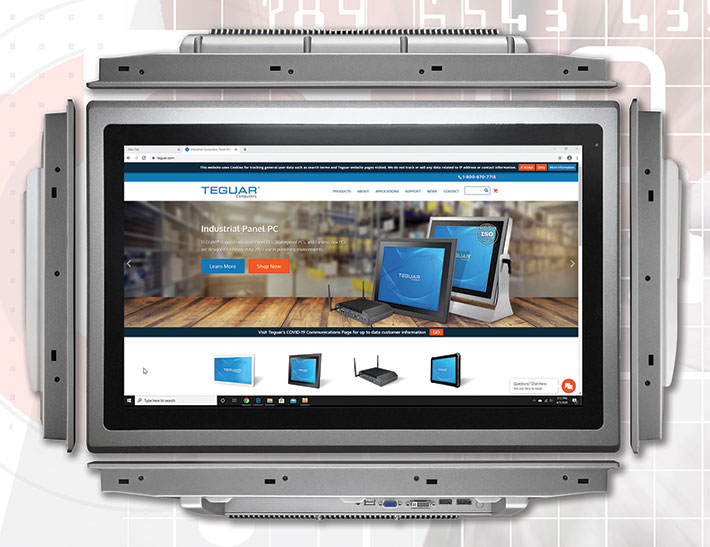
The backside of the TD-45-22 impresses just with the craftsmanship of that massive die-cast finned aluminum plate that looks like it could easily dissipate all the heat of a big Intel processor, except this is a monitor and there isn't a CPU (nor RAM or disks).
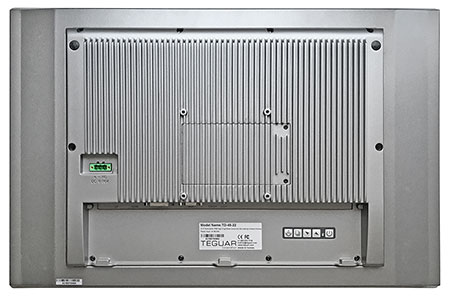 To the right you can see what the TD-45-22 looks like from the rear. On the left is the green power terminal block. Our machine came with an external power brick, but the monitor can handle a wide 9~36 range of DC input voltages. To the right you can see what the TD-45-22 looks like from the rear. On the left is the green power terminal block. Our machine came with an external power brick, but the monitor can handle a wide 9~36 range of DC input voltages.
For wall, desk stand, or other articulating arm mounting, there's the standard 100 x 100 mm VESA screw hole pattern. Sitting inside the pattern is an access door for expansion functionality.
Note the absence of speaker grilles or cutouts. That's because these industrial monitors are not meant for movie or YouTube viewing. If there is a need for sound, all ten models in the TD-45 industrial monitor series do have a speaker/audio port option.
 On the bottom right of the monitor's backside is the OSD (On Screen Display) membrane control panel that allows access to the usual variety of display settings. There's the on/off power button, up/left and down/right arrows, a menu/entry button, and one for on-touch auto adjustment. The panel isn't terribly accessible, but that's by design: on a kiosk or industrial display you don't want people messing with the controls. On the bottom right of the monitor's backside is the OSD (On Screen Display) membrane control panel that allows access to the usual variety of display settings. There's the on/off power button, up/left and down/right arrows, a menu/entry button, and one for on-touch auto adjustment. The panel isn't terribly accessible, but that's by design: on a kiosk or industrial display you don't want people messing with the controls.
Below is a look at the TD-45-22 monitor's input/output area, which is, apart from size-related positioning and configuration, functionally identical in all ten models. The emphasis here is on video connectivity. All ten models have a 15-pin VGA port and a DVI-D port. All but the three smallest ones also have HDMI and DisplayPort. All have either a USB Type A (Host) or USB Type B (peripheral connection) port. A DB9 RS232 is optional on all models.
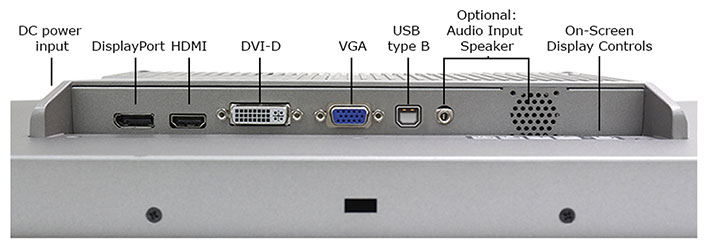
Note that all of these Teguar industrial monitors are listed as having their front panel IP66 protected. IP66 means totally dust-proof, and also able to withstand a strong jet of water. Why only the front panel? Because most such monitors will be panel-mounted in one way or another. It would make no sense to also seal the backside of the device that's inside a panel. Teguar further offers optional IP69K protection. IP69K is a less common designation that means a device can be spray-cleaned with high pressure (up to 99.97 bar/1450 psi) and high temperature (up to 80°C/176°F) water jets.
Opening up one of these Teguar industrial monitors should rarely become necessary. There are no hard disks or fans or much of anything else that could break or need upgrading. We, of course, took it apart anyway. It's easy. Undo ten Philips screws and the big die-cast aluminum back comes off. Careful, though: there are several wires between the two parts. For those interested in the particulars of the display: In the big TD-45-22 version we tested, it's an AU Optronics T215HVN01.1 A-Si (Amorphous Silicon) TFT LCD with vertical striping and nearly perfect 89-degree viewing angles from all directions.
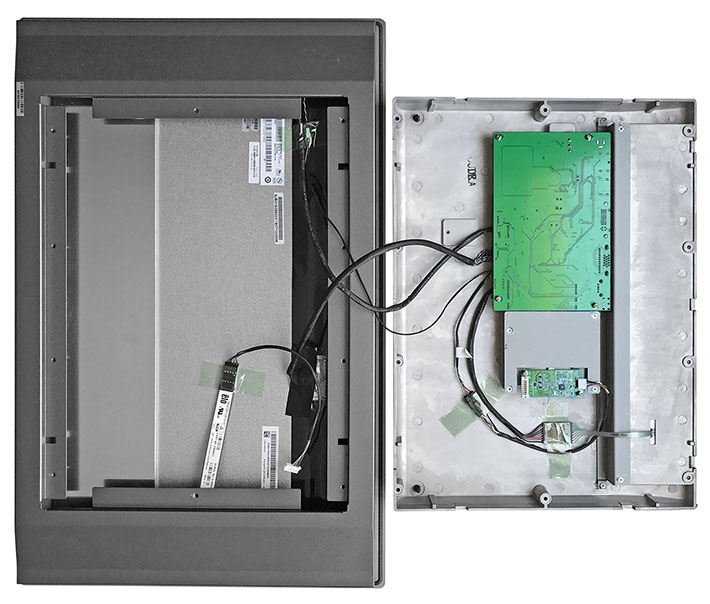
Above you can see what it looks like inside. The large green board handles power and all I/O. The small green board is for the touch interface.
High bright
Since industrial panels may be used indoors as well as outdoors, it makes sense to offers two brightness options. For indoors, 250 to 450 is plenty bright enough (a good laptop is around 250 nits, a modern tablet in the 400-550 nits range), for outdoor use it wouldn't be enough. As a result, Teguar offers all of their industrial monitors with a high-bright 1000 nits option.
 What makes for a "high bright" backlight? That's where luminance, the intensity of light emitted, comes in. Luminance is measured in candela per square meter, where candela refers to luminous intensity, the power emitted by a light source.
What makes for a "high bright" backlight? That's where luminance, the intensity of light emitted, comes in. Luminance is measured in candela per square meter, where candela refers to luminous intensity, the power emitted by a light source.
Since "candela per square meter" is a bit cumbersome, the industry uses "nits" which really is just short for "units".
We measured screen luminance of the TD-45-22 at five different levels of HSB brightness (see table to the right) and found a maximum luminance of 784 nits.
Given that the product specs say 1,000 nits, why did we find 784? That's because our sample unit came with a resistive touch screen. Resistive touch screen technology offers between 75 and 85% light transmission, which explains the 784 nits. That is still plenty bright, brighter than any premium consumer tablet.
Since our sample came with resistive, we couldn't measure luminance of the capacitive touch option that Teguar offers. It could be in the 90-98% range, so keep that in mind if maximum brightness matters.
Teguar TD-45 Series — Summary
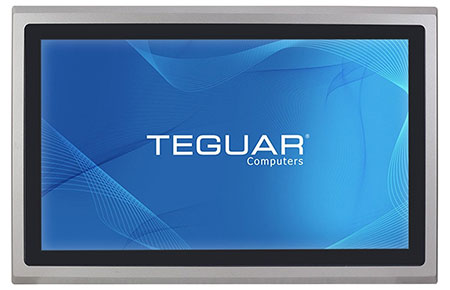 With their TD-45 Series, Teguar Computers offers a versatile lineup of heavy-duty industrial-grade monitors that can be mounted into control cabinets, integrated onto an OEM machine, or used in a manufacturing environment. With their TD-45 Series, Teguar Computers offers a versatile lineup of heavy-duty industrial-grade monitors that can be mounted into control cabinets, integrated onto an OEM machine, or used in a manufacturing environment.
Available in screen sizes from 7 to 21.5 inches, these touchscreen monitors offer a graphical user interface for machine operation, data viewing, self service activities, or interaction with ERP software. The monitors can be connected to an embedded box PC via VGA, DVI, HDMI, and DisplayPort. Or they can be connected to an All-In-One panel computer and act as cloned displays or dual screen monitors.
Employing die-cast aluminum and steel construction, Teguar's TD-45 industrial monitors are rock-solid and meticulously made. Resistive touch is standard, but IP69K versions are configurable with capacitive touch as well.
Teguar offers all TD-45 industrial monitors with optional high-bright (1,000 nits) display versions for daylight readable deployments.
After examining, using, and taking apart the Teguar TD-45-22 industrial monitor, as well as studying the specs and features of the company's entire lineup of such monitors, we came away impressed with the design, solid build, functionality, and overall quality of the line. —
Conrad H. Blickenstorfer, April 2020
 Teguar Computers
Teguar Computers
1-800-870-7715
www.teguar.com
|






